BTCparser3 User Guide
Working principles, advantages, and disadvantages of BTCparser3
One of the key principles of Bitcoin blockchain is its permanence and transparency. Any transaction (sending or receiving Bitcoin) will be registered in the blockchain, and after a confirmation, this information can't be edited or removed from the distributed database. Currently, the overall size of the Bitcoin blockchain exceeds 200 gigabytes, and it will only increase in the future. Special parsing software is used to monitor for large transactions and actions of big wallets. These parsers are used to collect all the necessary transaction details, process and analyze them. Most of these parsers analyse separate blocks.
The key feature of BTCparser3 is the ability to consolidate the data from groups of 100 blocks. The parser collects information from 100 blocks and identifies every wallet that has sent or received a total exceeding 1000 bitcoins. Furthermore, BTCparser3 calculates additional statistical information for every 100 blocks. All this information is then processed and published (at least once per day) on https://btcparser.com/3/ or the public channel in Telegram t.me/BTCparser3
What is the purpose of BTCparser3?
First of all, this parser provides a better understanding of the current state of blockchain and its operation. It evaluates the current load on the network by the number of transactions and their amounts, revealing the potential mood of big owners of bitcoins (whales and puppet-masters). With an aid of BTCparser3 everyone may see which addresses collect significant amounts of bitcoins, and spot on activity of biggest players (owners). This consolidated statistical information is easier to understand and has a greater use than the data provided by other bots processing single blocks independently.
Warning: Never try to use the statistical information provided by the bot to forecast short-term changes of the Bitcoin price. This information is used to gain a deeper understanding of blockchain technology, and it shouldn't be used as the basis for your trading actions and decisions.
Data recording format
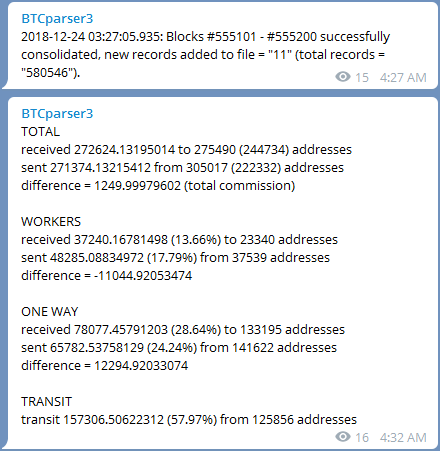
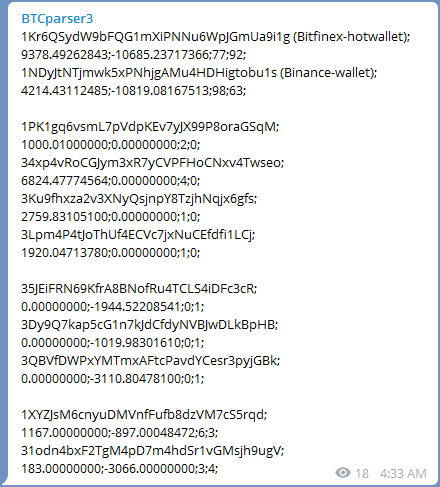 Telegram data output format
Telegram data output format
- The first message contains only general information.
- The second message includes a detailed statistics for different wallet types.
- The third message includes all bitcoin-addresses that received or sent more than 1000 bitcoins in total during the last 100 blocks.
Let's look at these messages more into details:
1st group
The first message includes the following information:
- The date and time the bot finished processing the last 100 blocks
- The number of analyzed blocks
- The number of filtered bitcoin-addresses (more than 1000 BTC in total were sent or received during the last 100 blocks). More detailed information about these wallets can be found in the summary below
- The overall number of addresses mentioned in 100 blocks (there can be duplicate entries). In fact, this is not the number of unique transactions, but the total count of addresses mentioned within each transaction.
For example, the following record: «2018-12-08 08:36:26.434: Blocks #552901 - #553000 successfully consolidated, new records added to file = "56" (total records = "840213").» means the bot has successfully finished analyzing and consolidating information from the range of blocks from 552901 to 553000 at 8 hours 36 minutes 26 seconds on December 8, 2018; these blocks contain information from about 840213 wallets. At the same time, 56 of them were used to send more than 1,000 BTC in total during the last 100 blocks.
2nd group
The second block includes the calculated statistical information. Let's take a look at it, but first, let's add some general information.
In the case of analyzing the behavior of specific blockchain users, there are several typical user groups and wallet types, we identified 3 main categories – workers, one way, and transit.
WORKERS - 'regular' working wallets. Their owners send and receive cryptocurrency. There's a difference between the number of payments and expenditures, thus the balance of the wallet has to be changed.
ONE WAY - 'donors/receivers' These wallets either had no outgoing or incoming transactions. In other words, bitcoins went only one way.
TRANSIT - 'temporary' wallets. They are only used to receive a specific amount of BTC and send it to another address. At the same time, the balance of these wallets never changes, because the total amount of incoming payments is equal to the number of outgoing payments.
Let's return to the second block of information provided by BTCparser3. This block includes the summary of the different wallet types. Let's look at an example.
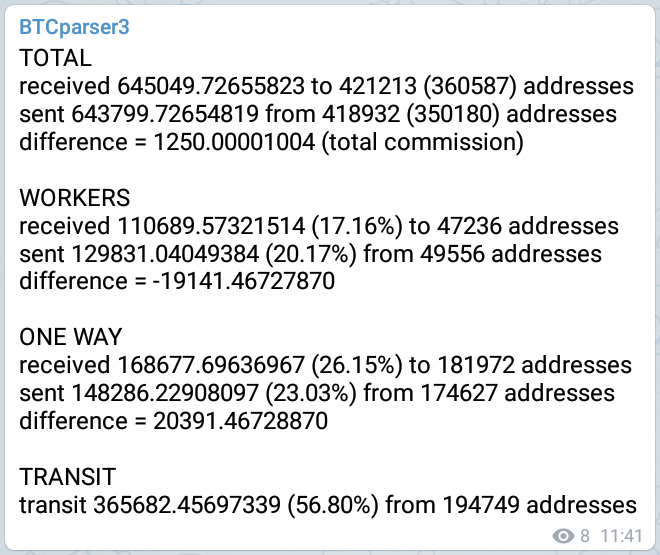 Statistics
Statistics
TOTAL – general information about all the confirmed transaction within 100 blocks:
- the overall amount of BTC received
- the overall number of IDs mentioned in the incoming transactions
- the overall number of unique receiving wallets mentioned
- the overall amount of BTC sent
- the overall number of IDs mentioned in the outgoing transactions
- the overall number of unique sending wallets mentioned
- the total fee for all the transactions within 100 blocks
 Statistics for 100 blocks
Statistics for 100 blocks
From this example, we can see that more than 643,799 BTC were sent, and more than 645,049 BTC were received during the last 100 blocks. The difference between the incoming and outgoing transactions is 1,250 BTC. There was a total of 421,2134 receiving wallets mentioned in the transactions (36,587 of them were unique), and 418.932 sending wallets (350,180 unique).
WORKERS – contains information about all 'general use' wallets used to send or receive Bitcoins (both incoming and outgoing transactions are available), and their balance is not equal to zero. These are the following rows:
- the total amount of all incoming transactions
- the percentage of wallets from the total number of incoming transactions
- the number of wallets used to receive Bitcoins
- the total amount of all outgoing transactions
- the percentage of wallets from the total number of outgoing transactions
- the number of wallets used to send Bitcoins
- the number of unique records made from sending wallets
- the difference between the amount of incoming and outgoing transactions
 Working wallets
Working wallets
As you can see, working wallets take just 17.16% from all incoming and 20.17% from all outgoing transactions.
WORKERS 1 to 1000 (sub-classification update from 2021) - We decided to further sub-classify this group of wallets. Mainly because there were addresses that sent out hundreds of bitcoins (and be called ONE WAY senders), but they received a few hundred of satoshis as blockchain-spam and that makes them classified as WORKERS. At the same time, there are whales who received thousands of Bitcoins, but for some reason sent out only a fraction of the Bitcoin. In other words, the amount they receive exceeds the amount they sent hundreds of times. And their behavior is very different from exchanges that receive and send very similar volumes (one never exceeds another even 2 times).
That gave us the idea, that we need to classify Workers by the ratio of how much they receive and send.
WORKERS-1 has a ratio below 10 (they either sent less than 10 times more than they received, or they received less than 10 times more than they sent). Normally these are exchanges.
WORKERS-10 has a ratio above 10 but below 100.
WORKERS-100 has a ratio above 100 but below 1000.
WORKERS-1000 has a ratio above 1000 and these are mainly whales and cold wallets of exchanges. As was mentioned earlier, the address that sent out all of its funds, but received some dust from the stranger will be classified into this category.
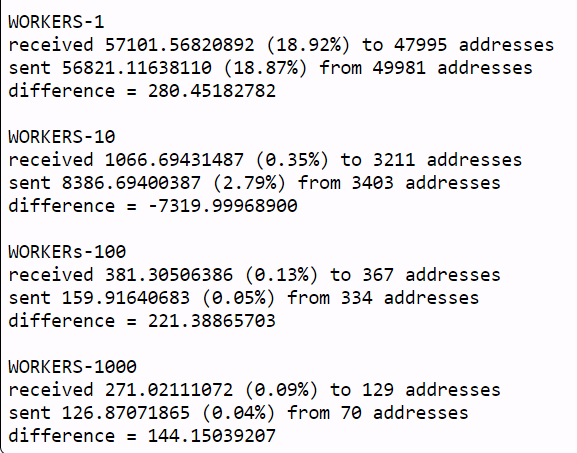 Working wallets sub-classification into WORKERS 1 to 1000
Working wallets sub-classification into WORKERS 1 to 1000
ONE WAY – contains information about the wallets used exclusively to send (contributing wallets - donors) or receive (accumulating wallets - receivers) Bitcoins. These are the following rows:
- the overall amount of all incoming transactions (for accumulating wallets)
- the percentage of wallets from the total number of incoming transactions
- the number of wallets used to receive Bitcoins
- the overall amount of all incoming transactions (for contributing wallets)
- the percentage of wallets from the total number of outgoing transactions
- the number of wallets used to send Bitcoins
- the difference between the amount of incoming and outgoing transactions
 Accumulating and contributing wallets
Accumulating and contributing wallets
In this example, during a period of 100 blocks, more than 168,677 BTC were received to 181,972 unique addresses, and more than 148,286 BTC were sent from 174,627 unique addresses. As a result, accumulating wallets take 26% from the overall amount of incoming transactions, while contributing wallets take a bit more than 23% from the overall amount of outgoing transactions.
TRANSIT – it's obvious that this section contains information about transit (temporary) wallets, which are used to send all received amount of BTC (immediately or part by part). If according to the statistical information of BTCparser3 the address sends amounts of BTC equal to the previously received amounts, the address is then added to the transit wallets group. The unique row contains the following information:
- the overall amount of transactions (values of incoming and outgoing transactions are equal)
- the percentage of wallets from the total number of transactions
- the total number of transit wallets identified within 100 blocks
 Transit wallets
Transit wallets
In this example, more than 365,000 BTC were sent through transit addresses, which is almost equal to 57% of the total amount of transactions! In fact, more than 194,000 wallets are used to simulate the cryptocurrency flow (fake volume).
Information from this statistical section makes conclusions on the current mood of holders with huge amounts of BTC, as well as evaluating the efficient (real) volume of transactions without transit wallets, which produce a lot of noise.
3rd group
After accumulating the data, the bot then provides a summary of those wallets used to receive or send more than 1,000 BTC within 100 blocks. The key feature of BTCparser3 is that it tracks overall wallet activity. For example, if a wallet is used to get 30 BTC per block, the majority of bots will simply skip this activity, trying to catch bigger transactions. At the same time, the owner is able to receive a huge amount of 1,500 BTC in just 100 blocks. Thanks to the consolidation of the information from 100 blocks, BTCparser3 allows tracking the activity of these wallets.
The summary below contains the following information about the wallets:
- An ID of the wallet, as well as the special tag for verified wallets
- the total amount of BTC received and sent to the wallet within 100 blocks
- the total number of incoming and outgoing transactions to the wallet within 100 blocks
Let's look at an example.
1NDyJtNTjmwk5xPNhjgAMu4HDHigtobu1s(Binance-wallet);11901.03374284;-17828.16151748;211;106;
During the last 100 blocks, the wallet with 1NDyJtNTjmwk5xPNhjgAMu4HDHigtobu1s ID (the wallet is verified and belongs to Binance exchange) was used to receive 211 transactions for the total amount of 11901.03374284 BTС. Furthermore, the wallet was used to make 106 outgoing transactions for the total amount of 17828.16151748 BTC.
The list of the wallets is divided into four groups:
- Verified and identified wallets (mainly wallets belonging to cryptocurrency exchanges). The owner of the wallet can be found in brackets after the ID.

- All ONE WAY receiving wallets (receivers). These are only used to receive BTC during the last 100 blocks.

- All ONE WAY sending wallets (donors). These are only used to send BTC during the last 100 blocks.
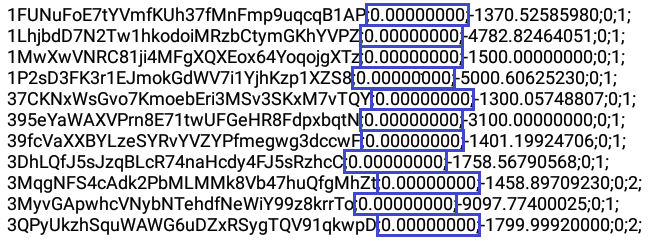
- 4. Other wallets (working and transit). In cases where the amounts of incoming and outgoing transactions are equal, the wallet is in transit and the balance remains unchanged. Otherwise, the wallet is considered a working one.

Advantages and disadvantages of the bot
- Information consolidation. Unlike many other bots, BTCparser3 analyzes 100 blocks at once, without processing them one by one. This approach tracks activity of the wallets on a long-term basis. In cases where the wallet is used to make a huge amount of small transactions, but the total sum reaches 1,000 BTC during the last 100 blocks, BTCparser3 will show information about this type of wallet.
- General statistics. This section provides an understanding of the overall situation in the blockchain, including the of transactions. Furthermore, information about the working, as well as contributing and accumulating wallets, can be easily accessed.
- Tags for known addresses (e.g. 'hot wallets' of biggest exchanges). Furthermore, activity for a given period of time can be tracked, understating the amount that was sent and taken from the exchange.
- Messages are sent around once per day, and the bot won't bother a lot regarding small transactions.
The biggest disadvantage of BTCparser3 is that it supports only the Bitcoin blockchain at the present moment.
Questions and answers
Question: What is the purpose of transit activity tracking?
Answer: Transit activity is just a simulation of real activity. If this 'noise' is excluded from the data, then the real volume of working transactions can be seen to make a proper evaluation of the current state of the blockchain.
Question: There are special services allowing mixing and hiding the identity of BTC. At the same time, whales never store huge amounts of BTC in one wallet. Is it possible to track this activity?
Answer: It is possible. Many users are trying to hide BTC ownership, 'spreading' huge amounts between dozens and hundreds of wallets and trying to make them look independent. At the same time, BTCparser3 is based on information consolidated from 100 blocks. If one of the addresses is used to send or receive at least 1,000 BTC, then transactions can be tracked by looking at each of the blocks. In reality, 'independent' transactions become dependent.
Question: I would like to track huge BTC transactions and I would like to receive information more than once per day, how can I do this?
Answer: You need to use BTCparser3 because it tracks information of each block, showing information about those wallets used to send or receive at least 200 BTC per block.
Question: The number and balance of accumulating wallets are higher than similar indicators of the working wallets, why is this?
Answer: Many things depend on the rates. Holders prefer to keep huge amounts of BTC, waiting for an increase in price.
